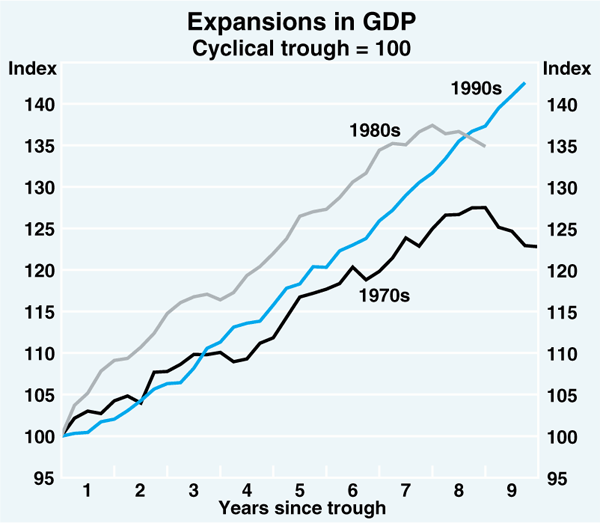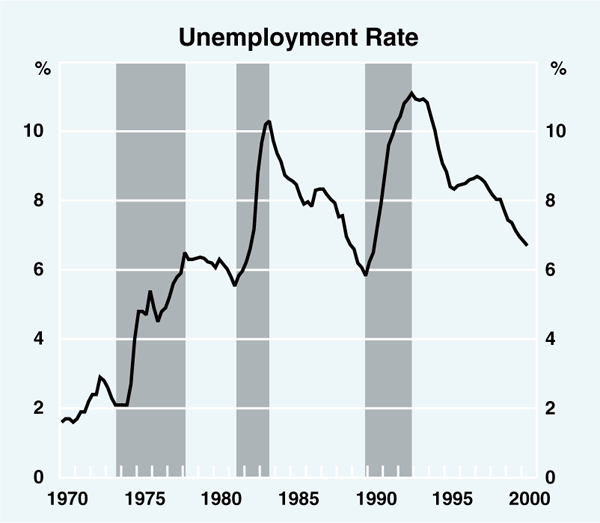Speech A Medium-term Perspective on Monetary Policy

I.J. Macfarlane
Governor
Address to Queensland University of Technology Business Leaders' Forum
Brisbane –
It is a pleasure to be here in Brisbane to address the Leaders' Forum Luncheon. I am not sure that I will have much to say about leadership, but I hope that my comments will be of interest and relevance to those attending today. I would also like to thank the Queensland University of Technology, which is to be congratulated for running this excellent series of lectures.
I would like to take the opportunity today to restate the underlying logic behind our approach to monetary policy. My reason for doing so is not that it is intrinsically difficult, and therefore in need of repetition in order to aid understanding. It is because the logic is essentially medium to long-term in nature, and hence tends to get lost in the day-to-day welter of economic statistics and associated commentary. For those whose interest is in the details of the current economic statistics, we will be publishing our quarterly review, The Economy and Financial Markets, next week.
Our approach to monetary policy, like that of a number of other countries in similar positions, is based on the achievement of an inflation target. This says that over the medium term, inflation should average somewhere between 2 and 3 per cent. We recognise that it will not always stay in this range – that is why it is expressed as an average over the medium term. The actual adjustment of interest rates, of course, is done on the basis of our assessment of the outlook for inflation, including a central forecast and a judgment about the balance of risks. But if we have done the job well, we should be able to look back and see that over a reasonable run of years inflation has averaged 2 point something per cent per annum.
So far in stating our approach I have not mentioned economic growth or employment, but there is a reason for approaching things in this order. It is not because we downplay the importance of growth and employment – we certainly do not, and in any case our Act makes it clear that to do so would be contrary to our mandate. We approach monetary policy in this order because there is overwhelming evidence to suggest that countries can only have sustained expansions if they are accompanied by low inflation. It is the sustainability of the expansion which is the key to maximising economic growth and employment. Thus, another way of expressing the aims of a monetary policy based on inflation-targeting is to say that its aim is to maximise the length of the economic expansion.
A cynical observer might say that it is all very well to emphasise the length of the expansion as the crucial test now that we all know that the current expansion has been a long one. But this is an approach which we have had for quite a long time. I remember explaining it to a Parliamentary Committee in early September 1996 immediately before I took up my present position.
I think there is a reasonable consensus forming in Australia, as there is in a number of other countries, that inflation-targeting is a good approach to monetary policy. The most persuasive argument in its favour is that the results achieved so far have been very good. For example:
- The current economic expansion, which started in the September quarter of 1991, has already lasted longer than its two predecessors and, on current indications, still has a fair way to go. Graph 1 shows the expansions which started in the 1970s, 1980s and 1990s. For the current expansion, the figures only go up to the March quarter 2000. Incidentally, the length of our expansion is very similar to the much better known US expansion – ours has lasted for 36 completed quarters (including June 2000), theirs has lasted for 37 completed quarters.
- During this time, economic growth has averaged 4.1 per cent per annum, with inflation averaging in the low two's. So the good result on inflation was not achieved by sacrificing our growth performance.
- While a lot of countries have done well over the past decade, the Australian performance stands out. We have grown faster than other comparable countries (including the United States) and our inflation rate puts us in the middle of the field. Table 1 shows that only Ireland, which had very special circumstances, grew faster than Australia.

In short, the results suggest that the inflation-targeting approach to monetary policy has been successful in achieving its aim. Also, the fact that Australia has been virtually at the top of the international growth league, while achieving a respectable middle order ranking on inflation, shows that we have not over-emphasised inflation control at the expense of economic growth.
While I think there is now a consensus that the inflation-targeting approach to monetary policy makes sense, there is always room for disagreement about how it is applied in practice. Such differences of view are part and parcel of the normal policy debate, and we of course participate in it and listen to other views. In passing, I should say that I think the debate is carried out in a much more civilised way these days, compared with a number of earlier periods I can remember. I attribute this improvement to the fact that there is now wider agreement on the underlying model than in earlier periods.
Nevertheless, differences of view remain, and I would like to say a few words about some of them today.
The first area where there is always room for differences of view is on how to interpret the many individual pieces of economic data that come in virtually every day. How important is any particular statistic? Is it indicating strength or weakness? Are there special factors that have to be taken into account before it can be interpreted? Does it have any implications for monetary policy? This ‘bottom-up’ approach is widely used and it means that there is almost daily discussion in the media and elsewhere of the current and future strength of the economy.
My observation over the past four years is that the bulk of people expressing a view on this subject invariably argue that the economy is weaker than the Reserve Bank judges it to be. There are very few on the other side to act as a balance. The majority of people who present a view think that the Reserve Bank has a recurring tendency to over-estimate the strength of the economy.
| Country | GDP | Country | CPI |
|---|---|---|---|
| Ireland | 6.3 | Japan | 1.0 |
| Australia | 3.5 | France | 1.8 |
| Norway | 3.3 | New Zealand | 1.9 |
| United States | 3.3 | Switzerland | 2.1 |
| Netherlands | 2.9 | Denmark | 2.2 |
| New Zealand | 2.6 | Finland | 2.2 |
| Canada | 2.5 | Canada | 2.2 |
| Spain | 2.5 | Belgium | 2.3 |
| Belgium | 2.2 | Australia | 2.3 |
| Denmark | 2.1 | Netherlands | 2.5 |
| Germany | 2.1 | Germany | 2.5 |
| United Kingdom | 2.1 | Norway | 2.5 |
| Finland | 1.8 | Ireland | 2.6 |
| France | 1.7 | Sweden | 2.9 |
| Japan | 1.5 | United States | 3.0 |
| Italy | 1.5 | United Kingdom | 3.5 |
| Sweden | 1.4 | Italy | 3.9 |
| Switzerland | 1.0 | Spain | 4.0 |
|
Source: OECD |
|||
This view is quite wrong: the fact is that we have consistently under-estimated its strength. You only have to consult my half-yearly appearances before the Parliamentary Committee to see that on every occasion I have had to explain to them why the modest slowdown in growth that we forecast did not arrive. The correct way of summarising the various views is to say that the Reserve Bank has under-estimated the strength of the Australian economy, while its critics have under-estimated by a larger margin.
This is not unusual. There is a tendency during the expansionary phase of the business cycle to be unduly influenced by the inevitable signs of weakness in some of the individual indicators and hence to lose sight of its underlying strength. There is a tendency for people to not be able to see the wood for the trees. This is true of most economists, bureaucrats, politicians, the press and, as I pointed out above, central bankers are not immune from it. It is one of the reasons why historically there has been a tendency to leave the tightening of monetary policy till too late in the cycle. By then, various imbalances – particularly, but not only, inflation – have become established and policy has had to be tightened by a larger amount than if it had been done in a more timely manner. This has been an important contributor in many countries to shortening the expansion phase or to making the contraction deeper and so producing a boom-bust cycle.
That is why if the central bank wants to have any hope of getting its timing right it has to move ahead of public opinion. This will mean that the tightening phase will inevitably attract criticism from various quarters and will be labelled by some as unnecessary or, at least, premature. That is why governments have entrusted monetary policy to independent central banks – in order to ensure that monetary policy is insulated from day-to-day political pressures, and to make it clear to the public that this is the case.
A second area where differences of opinion are often expressed is on how to reduce the level of unemployment. Now, in my opinion, there are a lot of policies that have a role to play in this task, one of which is monetary policy. There was a time not so long ago when economic purists, including some central bankers, often denied that monetary policy could affect unemployment – in their view, monetary policy only affected inflation. You will be pleased to know that I am not a member of that school. Bad monetary policy can certainly make unemployment worse, so it follows that good monetary policy can make it better than it would otherwise have been.
What is the best contribution that monetary policy can make to lowering unemployment? My answer is that the best thing it can do in the long run is to provide the conditions which maximise the length of economic expansions. We do not want a seven or eight year expansion followed by a serious recession as we have had in the past. The damage to unemployment occurs during recessions. The significant rise in unemployment that occurred in Australia from the early 1970s to the early 1990s was not due to a prolonged period of weak economic growth, it was due to the fact that we had three relatively short periods of recession, each of which resulted in a big lift in the unemployment rate.

To repeat, it is not the insufficiency of growth during the expansions which accounts for Australia's current rate of unemployment – it is due to the sharp rises that occurred during the recessions. To illustrate by reference to the US again:
- during our current expansion GDP has grown at a rate of 4.1 per cent per annum in Australia, compared with 3.7 per cent in the US;
- over the same period, we have reduced our unemployment rate from its peak by 4.6 percentage points compared with 3.8 percentage points for the US. The fact that their rate at 4.0 per cent is lower than ours at 6.6 per cent is entirely due to their lower starting point, which was due to the relatively mild nature of their early 1990s recession.
In short, it is clear that the best thing that monetary policy can do to reduce unemployment is to prolong the expansion and delay and reduce the size of any subsequent recession. On occasion, that means tightening monetary policy early to forestall inflationary pressures, as an alternative to more vigorous application of the brakes when inflation has built more momentum.
A third question which could be asked about our approach concerns Australia's potential growth rate. We are, I think, rightly proud of our growth performance during the current expansion, especially of our average of 4½ per cent per annum since mid 1997 when we were hit by the Asian crisis. But some may ask why we think 4½ per cent is a good result – maybe the economy was capable of growing a good deal faster without pushing up inflation by much. We have all heard of Australia's improved productivity performance in the 1990s, so why can't this allow us even more growth?
There are two answers to these questions – a mechanical one and a policy one:
- The mechanical one is that the potential 0 growth rate is determined on the supply side of the economy by the growth of the labour force and the rate of labour productivity. While the second of these is now about 1½ per cent per annum higher than in the 1980s, the first – the growth of the labour force – is 1¼ per cent per annum lower. This is largely due to lower growth in the working-age population, and a much smaller rise in the participation rate as the female participation rate is now already quite high and the male participation rate is declining. So the improved productivity trend has contributed to higher living standards, but its effect on total GDP growth has not been as marked.
- The more important answer is the policy response; it is one that I gave three years ago at a time when a number of critics were claiming that the RBA would not permit the Australian economy to grow by more than 3½ per cent per annum. The answer then, as it is now, is that we do not have firm views about a speed limit. Our tightenings or loosenings of monetary policy are determined by the inflation outlook. If the economy wants to grow faster than it currently is, and inflation is not showing any tendency to rise to the point where it could threaten our medium-term objective, then we would not restrict the economy's growth. That was true three years ago, and it is still true: the difference is that now inflation has moved up, whereas three years ago it was moving down.
The rise in inflation over the past year, though a little larger than forecasters had expected, is not an alarming event. But it is a reminder to us that it would have been unwise to continue with the stance of monetary policy we had in mid 1999. Monetary policy at that time was at its ‘maximum-expansionary’ setting for the decade, and in our view some degree of tightening was going to be needed if we were to successfully manage further progress in the expansion. A number of other countries reached a similar conclusion over the past 18 months for reasons not very different to the ones I have outlined above.
Conclusion
I have tried to give an outline of how the inflation-targeting approach operates and how it contributes to improved performance, not only on inflation, but also on output and employment growth. The outline is necessarily broad and I am afraid it will disappoint those who wish to have answers to specific questions such as why did we raise rates in one month rather than the next? – or why did we raise rates by 50 basis points rather than 25? Inevitably, the answers to these questions involve an element of judgment. But the truth is that the answers are not very important in the medium term.
Rather, it is the average level of interest rates that matters. Have we allowed them to stay too low and so encouraged the build-up of an inflationary process, or have we raised them too high and so set in train a contractionary or deflationary process? These are the important questions, and any judgment on them must be based on the medium-term performance of the Australian economy. This may not be a simple task, but I would suggest that a favourable judgment would require that the macroeconomic performance of the Australian economy be better than in earlier decades, and that it stand up well in comparisons with the experience of other countries over the same period.